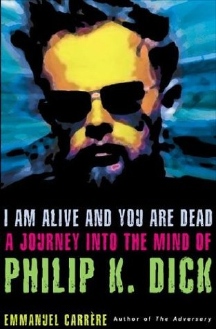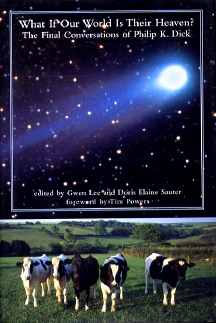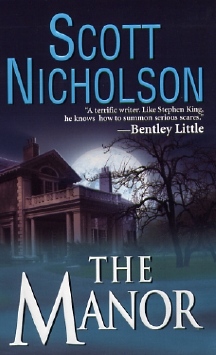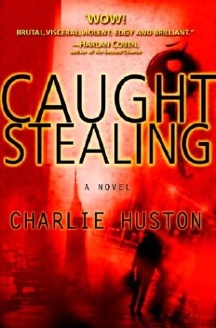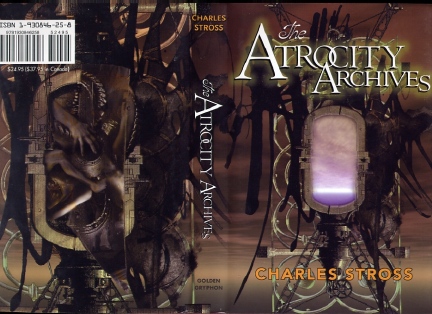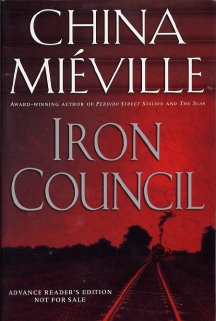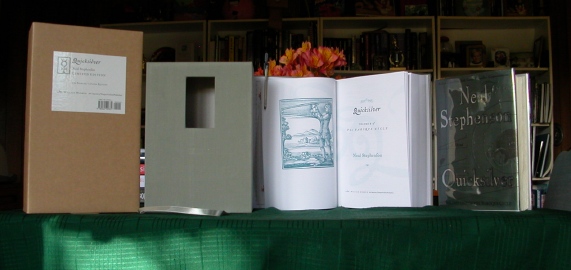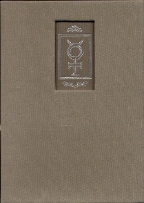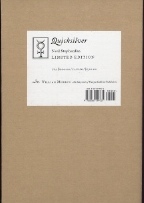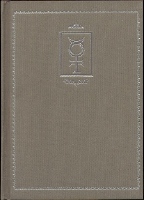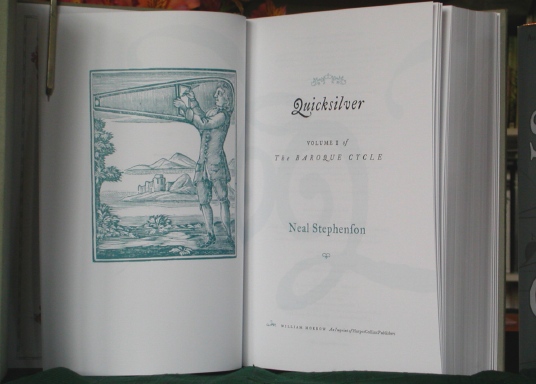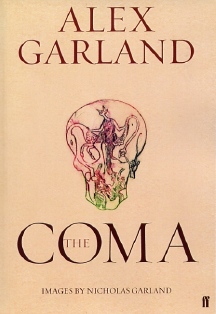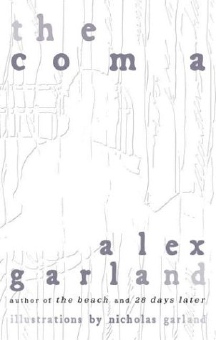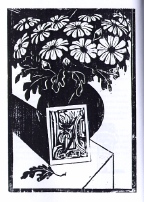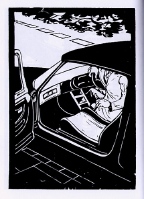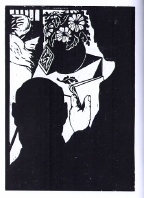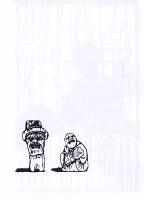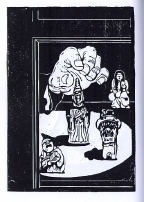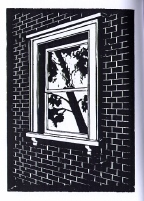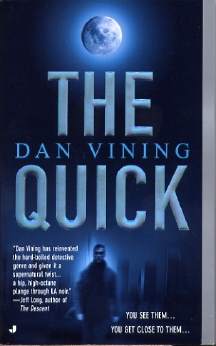|
|
|
This Just in..News from the Agony Column
|
06-11-04: I Am Alive and You Are Dead, Chill Out in the Appalachians |
||||||
Emmanuel
Carrere on Philip K. Dick
My interest in Dick stems from a couple of essays by Stanislaw Lem, published in his 'MicroWorlds' collection. Typical Lem polemics, they were the kind of writing that led Lem into famous confrontations with the Science Fiction Writers of America. You can read his version of the story here; and the SFWA'S here. They're not exactly congruent. But then, you can't expect science fiction writers of any country to be happy about one of their own writing articles titled 'Science Fiction, A Hopeless Case -- With Exceptions'. One of those exceptions was Philip K. Dick. I spent about three years and read about thirty novels, many of them the old DAW copies, many of them UK Orbit re-prints. I found Dick's writing packed with wonderful thoughts and his novels had a pleasantly downbeat love of the common man and the underdog that you don't often see on screen. It's hard to think of the movie stars who took the lead roles in most of the films as the everyday men that Dick liked to write about. Even more fascinating was Dick's life. He was part of the crowd who used to hang out in downtown Santa Ana, not far from where I once got the best (and only) lamb burrito I've ever eaten. There, in a loft with Tim Powers, James Blaylock, K. W. Jeter and an occasional appearance from Dean Koontz, Dick enjoyed a professional personal connection to writers who shared his odd vision of writing and life in these Untied States. His problems with substance abuse, women and reality are well known in general. But I haven't seen a biography of the man that's captured my imagination -- until now.
'I Am Alive and You Are Dead' (Metropolitan Books/Henry Holt, on sale now) is Carrere's 1993 biography of Philip K. Dick, now available as translated by Timothy Bent. To my mind, it seems weirdly appropriate that a Frenchman would write a biography of Dick, and I suspect that Carrere might be able to get the perfect vibe for this unusual man. I also like the fact that this isn't a book-brick, detailing one thing after another but appears to be more of an overview, a perhaps biased overview, but focused at least through this fascinating author's point-of-view. And hell, you've got to give a lot of credit to anyone who can manage a title like that, even with a subject as flamboyant as Philip K. Dick. Pick this one, and the companion volume -- so to speak -- 'What if Our World is Their Heaven? The Final Conversations of Philip K. Dick', edited by Gwen Lee and Doris Elaine Sauter, with a forward by Tim Powers (Overlook Press). Immerse your self in the mind that seemed to anticipate this century's maddest excesses. Hope he's wrong, even as you suspect he's right. |
||||||
Scott
Nicholson Visits 'The Manor'
I really enjoyed Scott Nicholson's debut novel, 'The Red Church'. With the right proportions of grit, technique and terror, it was one of the most enjoyable horror novels I've read in many a year. So I'm looking forward to catching a chill when those NoCal temperatures head into the 70's (that's Fahrenheit, global warming's not got that bad yet) while reading his latest novel, 'The Manor' (Pinnacle Books/Kensington Publishing, September 2004). That September date translates to mid/late August, so you'll have plenty of time to enjoy this book on the beach, something we're currently cobbling together a little column about. 'The Manor' is an artists' retreat in the Appalachian mountains, once owned by Ephram Korban. I don't think I've ever met an Ephram I've liked. At the Manor, sculptor Mason Jackson is making a succeed-or-die attempt to carve the one-time owner's likeness out of wood. Sylvia Hartley, the mountain witchwoman is connected to Korban both before and after his death. And Anna Gallows, a parapsychologist diagnosed with metastasized cancer is having dreams where she sees her own ghost -- in Korban Manor. Presumably this is not a happy, empowering dream. She's not flying. Once again, Nicholson is keeping things close to his own digs, and benefiting from the general Appalachian writer's vibe. His website, at HauntedComputer.com, has lots of interesting stuff about Appalachia. Sharyn McCrumb has made a good living writing about these mountains and their strange inhabitants, both living and dead, and one hopes Nicholson will as well. We're starting to see a return of the kind of horror that blew out the business in the 1980's, but in a more muted form, more suited to the long run. If that means we can have a steady stream of nice, chilling novels from Scott Nicholson, I'm on board. Even if I do have to meet some unpleasant people -- living and dead. |
|
06-10-04: Feel Sorry for the Cat, Beyond Top Secret with Charles Stross |
|||
| Charlie
Houston's 'Caught Stealing' updated 06-17-04 by Terry D'Auray
Charlie Huston's debut novel, 'Caught Stealing' (Ballantine/Random House) is garnering league-leading praise. It's the May selection from New York's The Mysterious Bookshop's First Mystery Club and I wouldn't be surprised to find it selected by other debut mystery clubs in the weeks ahead. 06-17-04: In my news brief on this book a week or so ago, I said I thought it would be picked up by other stores' book buying clubs. It's now the June pick for Poisoned Pen's Hardboiled Crime Club. The book introduces Hank Thompson, a promising major league baseball player forced out of the game by an injury sustained while stealing third base, now availing himself of the ever-ready supply of booze as a bartender in New York's Lower East Side. Asked to cat sit by a friend, he enters a decidedly violent "they're out to get me but I don't know why" kind of adventure that involves Russians, cowboys and assorted goons pitted against Hank and the cat. A hardboiled neo-noir thriller with a cat? Far cry from Lillian Jackson Braun territory here. Almost as juicy as the promise of the book itself are some of blaring blurbs. (Harlan) Coben-the-Ubiquitous strings together some pretty enticing adjectives "…brutal, visceral, violent, edgy and yes, brilliant…" But my favorite is Wallace Stroby ('The Barbed Wire Kiss', in my owned but not yet read stack) who strings together some pretty enticing personalities by saying "Tarantino meets Hitchcock meets Westlake meets Bukowski. …Reads like 'The Maltese Falcon' on crack". With those adjectives and those guys, I'm starting to feel sorry for the cat. |
|||
Enter 'The Atrocity Archive' with Charles Stross
Last week, I mentioned that the folks at Golden Gryphon are working to rule the world, what with the release of so many top-notch desirable books. This week, I offer evidence that they've already done so; we just haven't been told yet. You'll find all the evidence and more in breakout writer Charles Stross' 'The Atrocity Archive'. Most of us only know Stross as a science fiction writer on the leading edge of space opera with a heavy-duty dose of information theory and school-of-hard-knocks sysadmin experience -- as evidenced in his novels 'Singularity Sky' and the forthcoming 'Iron Sunrise'. 'The Atrocity Archive' will come as a very pleasant surprise. It's a page-turning spy novel set in a world where the father of computers, Alan Turing, has helped unleash extra-dimensional monstrosities that threaten mankind with math so evil it can undermine the fabric of reality. Finally, fiction to motivate your children to do their sums -- James Bond with a calculator! This volume contains both 'The Atrocity Archive' (originally serialized in Spectrum SF magazine) and 'The Concrete Jungle', a new novella featuring Bob Howard, the insubordinate hacker who makes his way from one end of the earth to worlds beyond imagination. That is, until Stross describes them in stunning set-pieces that back up non-stop action with high-flying, intelligent concepts. Yes, Stross is single-handedly putting the intelligence back in Intelligence. It's a mighty job, but if anyone is up to it, it's Charles Stross. And when they ask me to, I'll stand up in front of the United Nations and tell them that, "Stross says it is so; and thus, it must be so. There are weapons of mass destruction in so-called 'lost' Rl'Yeh." From the intelligent concept behind the story to the breakneck pace, this novel is would be an ideal beach-reading page-turner. With the basis in history and the esoteric facts behind the fiction, it would seem to appeal to the same audience that's currently so intrigued with novels that combine history and intrigue. But what sets Charles Stross apart from the brainless beach thrillers, beyond his obvious intelligence, is his sense of humor about the whole thing. Stross knows how to create absurdity, observe absurdity, and how to make us laugh with him at his creation even as we thrill to the details. Secret intelligence agencies, obscure mathematical and computational theorems, desk-jockeys, cosmic evil and high-tech magic might collapse under their own weight were it not for Stross' ability to buoy them with actual intelligence and witty repartee that's all-too-real. As usual, you can expect a book that you'll want nowhere near the beach from Golden Gryphon. A luxurious jacket painting by Steve Montiglio captures the creepy steampunk cyber-feel of the text. Ken Macleod gets to exhibit his own sense of humor in the introduction, which by itself justifies the modest price of the book. But beyond the title novel and the added novella (previously unpublished), you get Charlie's "Afterword: Inside the Fear Factory" and a two-page "Glossary of Abbreviations, Acronyms and Organizations". It's almost too much fun. I can't imagine for the life of me why, in a world that turns a certain novel into the best-selling book of all time, this book isn't being pumped off the shelves in airports around the globe. It's not like there actually could be a top-secret government agency, dedicated to concealing the truth about the pervasive influence of evil in this world? It couldn't be because Charles Stross is on to something. Could i#FFFFFFFFFFFFFFFF |
|
06-09-04: Looking to the Future |
||||||
Ian
R. Macleod and China Mieville
"The book previously known as Electricity is now called, more officially, The House of Storms. It's sold here in the UK and the USA to the same publishers as The Light Ages, which it follows on from in terms of basic premise, although the characters and setting are different. It will be out next year. Meanwhile, I'm at work on another novel, provisionally called Twilight Sonata, which has a near-future setting and is about, amongst other things, virtual immortality and the end of the world." A quick look at Ian's website shows that while he hasn't updated yet, there's enough there to more than whet the appetite. You'll find a nice, big excerpt from 'The House of Storms', and you're likely to really enjoy reading it. It looks as if this novel will be set in the midst of a surreal war, one part World War One, one part Lord of the Rings, with a sum far exceeding the total of the two. Ian's website also includes his article for the Independent on 'Alternate Londons'. "This isn’t the best of times to be in England…" Or anywhere else for that matter.
But not, he assured us almost a year ago, more important than the monsters. Of course all of this is baseless speculation when I could and soon will simply open the book. Mieville is one of those authors who make you realize that movies can never, ever compete with great literature. He packs in all the visual effects that only you can imagine, and backs them up with carefully conceived characters that you -- and clearly he -- care greatly about. His fine prose is detailed and subtle, transparent enough to offer a great view, but personal enough to cleave to the single reader's reading experience. You'll be able to open 'Iron Council' soon enough, and once again, you can experience the awe and mystery that reaches from Mieville's inner mind -- to your Outer Limits. |
|
06-08-04: A Quick Look at QuickSilver Ltd |
||||||||||||||||
HarperCollins, Wm Morrow, Hill House and Neal Stephenson for the Unlimited Budget
Be still my filthy fingers! Touch not these pristine pages. That's all
I can say as I shuffle through the limited edition of Neal Stephenson's
'Quicksilver'. And yes, I do have a bad habit of reading limited editions.
One of my great reading memories is the time I spent re-reading Tim Powers'
'Last Call' in the Charnal House Limited edition on the shores of Pinecrest
Lake during a long gone but never-to-be-forgotten vacation. And yes you
can see a bit of the wear I caused in reading that most expensive volume.
Still I don't regret a thing. But sometimes I wonder if Demco shouldn't
offer some sort of reading gloves for the collector who really wants to
enjoy that limited edition. The real question is: should you buy that limited
'QuickSilver'? My answer is a conditional yes. But more than a conditional
yes, I'm going to give you a close look at what you'll see and what you'll
get when you fork over the $200.00 plus shipping, sales tax and handling
for this most delectable volume.
The first thing you'll note is a decent sort of cardboard box holding the book itself. It fits together smoothly and has a nice-looking label on it. Don't just rip it apart in search of the gem within. Trust me, you're paying for it, and you'll want to keep it.
Well, you're down to the skinny now. Except that it's not skinny, it's huge and fat. While the whole book itself is only about half an inch higher than the trade version, the pages are a good inch higher. The book is printed on an ultra-white heavy stock, and is paginated in the same manner as the trade edition. This is going to come in handy if you actually read this particular volume. You can sit at home, be-gloved in your repose, sipping your favorite beverage and reading the luxury version in the rays of the setting sun. Then, when you want to read it at the local tacqueria, you can take your trade edition and easily find your way around. Without the danger of finding spattered salsa on your precious limited-edition's pages. (Or having to wear your reading gloves in public.) Open your new limited edition and you'll find somewhere in the credits that the it's the product of a collaboration between Hill House Publishers and HarperCollins. The book is designed by Shubhani Sarkar, who designed the trade edition for HarperCollins. This consistency will turn out in your favor.
Inside, you're going to find a whole new world of whiteness. You'll also find subtle blue highlights on the pages, a signature page, and...well, pretty much the contents of the trade edition. The book has been re-designed into a much larger format, and the combination of paper and format make this a book that would clearly be a pleasure to read. And that's important when you're talking about a 900-plus page book. So what does your $200.00 get you? Well, you don't get a lot of what
you usually hope for from limited editions. That would be extra material,
new
prose, or unpublished passages. You also don't get a first edition.
The trade edition of the book came out last year, after all. You
do get one
of 1,000 copies of the first limited edition book from Neal Stephenson,
and a handsomely designed and bound volume. |
|
06-07-04: Awake, Asleep, Alive or Dead? ; A Sinister Visitor On the Front Porch |
||||||||||||||||||
Alex Garland Emerges from 'The Coma' Updated
06-21-04: Sample Pages Online at Faber & Faber
But Hollowood juice is Big Juice. It's the kind of Juice that takes a novella length story from a promising writer and gets it not one but two deluxe editions and 40 woodcuts from the author's father, Nicholas Garland, a famous political cartoonist in UK. And that's just whata we've got with Garland's new novel, 'The Coma'. [<- 06-19-04: Now read and reviewed the title link.] So how does the Real Deal measure up to the windup and the pitch? I'm here to give you a preview, Courtesy of He Who May Not Be Named But Must Be Thanked. I'm reading the book at the moment, so all I can give you is impressions - a preview, not a review, which, as you know, will be much more thorough. But here’s what we can reveal, without revealing too much. First the particulars of the story, such as we are wont to tell. As usual, you may find out a bit more on the dust jacket. You're advised not to look.
Then he's waking up in a hospital room. Or is he? Because the reality that he's waking up to starts to bend ever so slightly. And while we all know that reality is plastic, Carl's is a little too bendy to be an overall good sign. In 'The Coma', it appears that Garland is once again re-inventing a wheel, in this case the 'Is the narrator alive, dead, or dreaming?' wheel probably first rolled off the line by Ambrose Bierce in 'An Incident at Owl Creek Bridge'. Now it's well known that this particular wheel is good for a lot of mileage in the right hands. Countless wonderful episodes of the 'The Twilight Zone' are driven by this trope. Philip K. Dick practically turned it into a literary genre of its own. Writers of every stripe and every genre -- from cheesy horror to high-falutin' litrachur -- have had their way with this particular idea. Given that Garland did a bang-up job on re-working the old Apocalyptic Afterlife in his most recent outing, the screenplay for '28 Days Later', it's quite possible that his are indeed the right hands.
In the interim, readers are offered four, count 'em four -- different versions of this novel when it goes on sale towards the end of this month. In a move mirroring the effort by HarperCollins on Neal Stephenon's Baroque Trilogy, we have a case where Faber, a relatively large-press publisher is offering not only trade editions of the book, but limited and boxed sets as well. For those of us hoping to read the book on The Beach, there's the study, portable trade paperback, clocking in at £9.99. That's an eminently reasonable price for an illustrated, brand-new novella by a hot author. PS Publishing's paperback editions, one must note, include equally enticing writers and are signed/limited to boot. So there's your reading copy. Your display library copy will be the £16.99 trade hardcover. Crass Americans can shell out some $19.99 in a week or two for the US version, and if you're feeling compulsive you can pick up this version as well. But you haven't gone very far down the path to compulsion unless you spring for one of the two limited versions offered by Faber & Faber. The "Limited Edition" will set you back a whopping £150. (As of 6/6/4, that's $275.63) It's not clear what the "Limited Edition" includes, but it had better be pretty deluxe. [I've just got the $200.00 Stephenson limited and it's pretty sweet, let me tell you. (But not my wife!) I'll be reporting on it in detail later this week. Be prepared to spend $200.00. Oh the lengths I go to for my readers!] But wait -- there's more! Not content with three different editions released simultaneously, Faber is offering a "Boxed Set" at -- wait for it -- £250.00! (That's $459.38.) Yow! My guess is -- and this is only a guess, which I'll try to confirm in the coming days -- that this includes actual woodcut prints. To my mind that would quite easily justify the price. I find it fascinating to see what the big publishers are doing with the "Limited Edition" concept, and how they're knuckling in on a market currently --and rightly -- owned by small press publishers like PS Publishing, Cemetery Dance, Subterranean and Night Shade, to name just a few of the usual suspects. (Immediately click on these URL's, and buy something from each publisher. They all have to-die-for titles. You will be really happy.) With luck, the limited editions by these big-name authors from the big publishers will draw attention to the work of the smaller presses and their authors. But you also have to remember to support the other authors -- for example, like Paul Park, Terry Bisson, Ian R. Macleod and Ken Macleod -- by picking up their work in hardcover. If you don't, a huge chunk of your reading selection will simply vanish. And in the end, as desirable as all four editions of Garland's latest are, even more desirable is one each of those from Garland, Park, Bisson and the Two Macleods. We all got here on those natty paperbacks. Readers have to make sure their reading dollars, pounds or Euros count. Any book you buy and read will have repercussions. It will keep somebody writing. As a reader, for the readers -- that's a good thing. I've just been notified that Faber and Faber, the UK publisher have put some sample pages online. Now, these do not include the woodcuts, and that will impact the reading experience. But you can get the flavor of Garland's prose. Just follow this link and enjoy the prose stylings of Alex Garland. |
||||||||||||||||||
|
Terry
D'Auray Takes a Quick Look at Dan Vining's 'The Quick' by Terry D'Auray
'The Quick' looks to be a blend of gumshoe and ghost story, something of a supernatural noir novel that promises to be both hardboiled and creepy. It features L.A. private investigator Jimmy Miles uncovering the secrets behind a murder while pitted against "the restless few" who roam the nightworld called "Sailors". Now "Sailors" don't sound all that sinister, but I bet they turn out to be. A quick check of the first chapter reveals a Mensa party where Miles meets "the woman", the start, as we all know, of nothing but trouble. It's written in classic hardboiled prose - "she…had a cigarette smoldering and a little chrome .25 automatic in her clutch bag. And a hurt in her heart." Oh yeah! Those instincts were right on.
|
